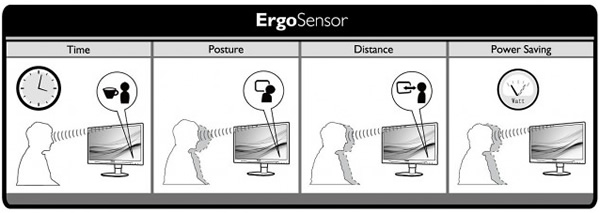Philips has launched a new 24 inch monitor which aims to help computer users – like a nagging school teacher – to sit upright, take breaks and maintain a proper distance away from the display. The LCD display utilizes an integrated CMOS sensor to determine the users position, distance and neck angle and provides corrective feedback so users know they've got it right when they do try to readjust themselves.
The display hasn't hit the U.S. yet, but it is available in the E.U. for a rather stiff €285 or about $373. That's considerably more than the average for a typical, non-IPS 24" LCD.
The LCD features a fully adjustable base called SmartErgoBase which swivels, tilts, rotates and actuates, ensuring virtually any user can find a comfortable position. This is key to a comfortable computing experience.
"This is an important feature to include in the monitor, Rempel says: 'We know that if a monitor is set too high or too low, and a person has to work with their head in extension, it can lead to neck pain.' Rempel advises people to set their monitors so that it is at a 10- to 20-degree angle below the horizon of their eyes." Source: wired.com
The display also features other bells in whistles. For example, the ErgoSensor utilizes its CMOS camera sensor to tell if you're near the computer or not. If you step away, the display will turn itself automatically to save power. Also included is Philips' proprietary SmartImage technology, a feature which can analyze the content of your screen and automatically adjust visual aspects like color temperature, saturation and contrast to what it believes are the optimal settings for your environment.

In addition to being ergonomically conscientious, the ErgoSensor display aims to also be environmentally sensitive. The device is shipped in 100 percent recyclable packaging, made from 65 percent post-consumer recycled plastics, uses a "minimal" amount of energy and features a "zero power" switch which draws 0 watts when switched off. The ErgoSensor display qualifies for TCO Edge, a stricter-than-normal program for "greener" electronics, meaning it uses fewer hazardous materials and completely eliminates certain chemicals, like halogens.
